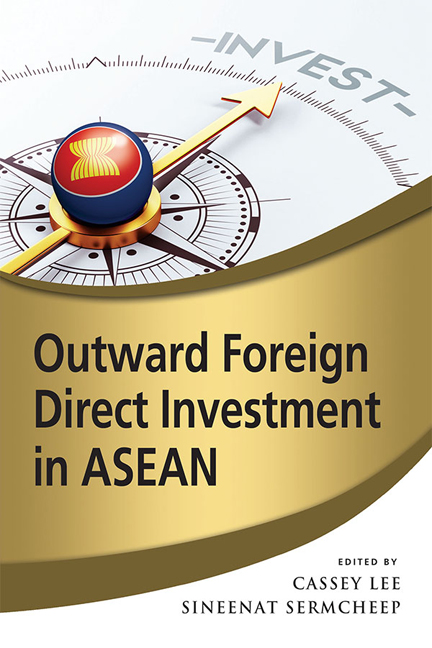Book contents
- Frontmatter
- Contents
- List of Tables
- List of Figures
- Foreword
- About the Contributors
- Introduction
- 1 The Rise of Outward Foreign Direct Investment from ASEAN
- 2 ASEAN's Outward Foreign Direct Investment
- 3 The Impact of the ASEAN Economic Community on Outward FDI in ASEAN Countries
- 4 Determinants of Singapore's Outward FDI
- 5 Outward Foreign Direct Investment from Malaysia
- 6 Indonesia's Outward Foreign Direct Investment
- 7 Factors Influencing Thailand's Outward FDI
- 8 Outward Foreign Direct Investment: The Case of Vietnam
- 9 Myanmar as a Destination for OFDI: A New ASEAN Foreign Investment Frontier
- Index
Introduction
Published online by Cambridge University Press: 19 May 2017
- Frontmatter
- Contents
- List of Tables
- List of Figures
- Foreword
- About the Contributors
- Introduction
- 1 The Rise of Outward Foreign Direct Investment from ASEAN
- 2 ASEAN's Outward Foreign Direct Investment
- 3 The Impact of the ASEAN Economic Community on Outward FDI in ASEAN Countries
- 4 Determinants of Singapore's Outward FDI
- 5 Outward Foreign Direct Investment from Malaysia
- 6 Indonesia's Outward Foreign Direct Investment
- 7 Factors Influencing Thailand's Outward FDI
- 8 Outward Foreign Direct Investment: The Case of Vietnam
- 9 Myanmar as a Destination for OFDI: A New ASEAN Foreign Investment Frontier
- Index
Summary
Southeast Asian countries have historically engaged in international trade long before the arrival of European colonial powers in the sixteenth century. The prospects and potential gains from trade and the control of the sources of natural commodities attracted these powers and eventually led to the colonization of much of Southeast Asia. With the exception of Thailand, which was never colonized by any European power, much of Southeast Asia became further integrated with the global economy as foreign colonies. In the aftermath of the Second World War, countries in the region gained independence and with it, sought to develop their economies via export-oriented industrialization. This did not take place simultaneously and concurrently amongst countries in the region. Political and institutional differences meant that some countries (such as Malaysia, Singapore, Thailand and Indonesia) had an earlier head start than others (such as Cambodia, Laos, Myanmar and Vietnam). As a result, there are still large differences in the level of development amongst countries in the region. This continues to be a significant challenge for member countries of the Association of Southeast Asian Nations (ASEAN) as they seek to achieve higher levels of regional economic integration.
One important manifestation of the differences in the level of development amongst ASEAN member countries is the difference in the patterns of foreign direct investment (FDI). At the initial stage of development, most ASEAN countries have abundant labour but lacked capital and technology. For ASEAN countries that adopted the export-oriented industrialization strategy early, the inflow of foreign direct investment (inward FDI) into the export-oriented industries in the manufacturing sector helped overcome these limitations. Over time, as higher levels of development and income per capita were attained, the factor composition in these more developed ASEAN countries began to tilt towards greater capital intensity and higher technology. At this juncture, enterprises in these countries, both local and foreign-owned, began seeking countries abroad to invest in — with the hope of establishing production facilities and/or accessing the final markets in these countries. The result is the emergence of outward FDI (OFDI) from the more developed ASEAN countries. The above transformation has been observed amongst ASEAN countries. Singapore, Malaysia and more recently Thailand has become net-investors in which outward FDI exceeded inward FDI.
- Type
- Chapter
- Information
- Outward Foreign Direct Investment in ASEAN , pp. 1 - 4Publisher: ISEAS–Yusof Ishak InstitutePrint publication year: 2017

